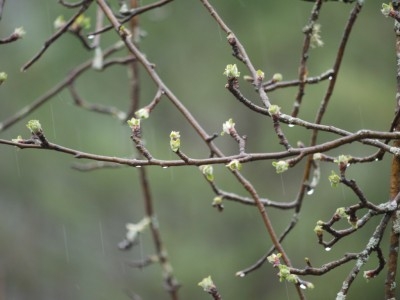
The term “temperate fruit tree” refers to trees that go dormant in winter, preferring moderately cold winters without the killing freezes of the coldest zones. Dormancy begins in late fall and lasts into early winter, initiated by lengthening days and cooler temperatures; it is chemically wrought by hormones suppressing buds for next season's foliage and flowers until conditions are right for tender new growth.
What is critical is how the tree breaks dormancy. Trees listen for the signal that yes, winter has arrived. The necessary signal strength varies between species, but is officially referred to as “chill hours”, or vernalization, when the temperature stays between 32°-45°F. The hormone responsible for dormancy breaks down in this range, allowing buds to develop into flowers or foliage when the weather warms up in late winter. Interestingly, temperatures below 32°F are ineffective and do not count; hours when temperatures exceed 60°F are actually subtracted from the accumulated chill hours.
When a tree does not receive the necessary signal to break dormancy, the buds tend to leaf out later, and the flower buds may appear irregularly, which can result in a longer bloom period. This may seem beneficial, but flowers are delicate things, and the longer the bloom period, the more likely they will be exposed to diseases such as fire blight and brown rot, meaning a harvest of fewer and deformed fruits.
Why all this talk about tree signals and deformed fruit? Climate change is making warm winters more frequent, resulting in poor harvests for certain fruit trees. As stated above, some require more chill hours than others, depending on species and varieties within species. Choosing “low chill” (requiring less than 300 hours at 32°-45°F) will hedge your bets, with the added benefit of getting more for your water and compost inputs when chill-needy trees have a low yield.
Figs, olives, and quince have the lowest natural chill requirements, followed by persimmons, pomegranates, almonds, and chestnuts. The more commonly grown fruits such as cherries, apples, peaches, and plums required breeding to develop low-chill varieties for folks living in areas like southern California where chill hours are minimal. Fortunately, us valley-dwellers can benefit from this horticultural achievement as well.
For a list of low-chill fruit tree varieties, I recommended visiting the UC's California Backyard Orchard webpage:
http://homeorchard.ucanr.edu/Fruits_&_Nuts/
Select a fruit and click on “varieties for planting in the home garden” and scroll down to the list of low-chill varieties, if applicable (naturally low-chill species such as fig and persimmon will not have a separate list).
If you have a gardening related question you can contact the UC Master Gardeners at 209-953-6112. More information can be found on our website.